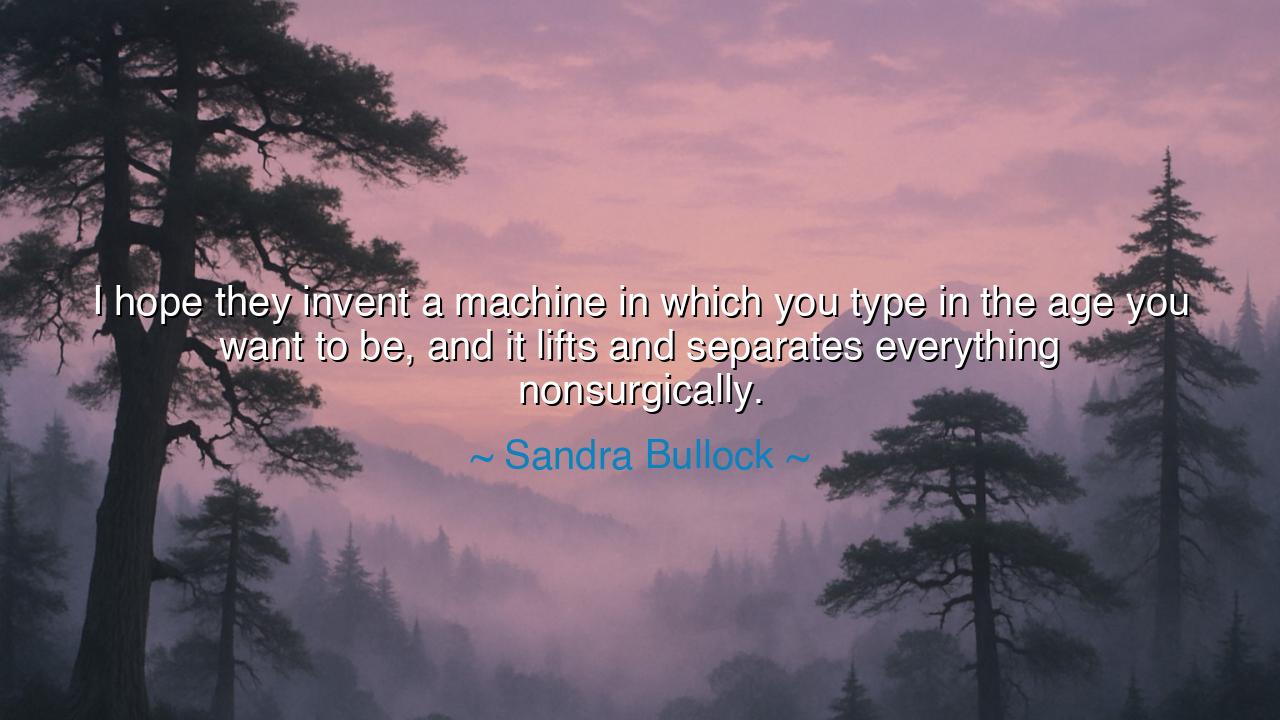
I hope they invent a machine in which you type in the age you
I hope they invent a machine in which you type in the age you want to be, and it lifts and separates everything nonsurgically.






In the timeless dance between youth and age, there lies a profound truth: aging is not simply a biological process, but a complex journey of acceptance and transformation. Sandra Bullock offers a playful yet poignant wish when she says, "I hope they invent a machine in which you type in the age you want to be, and it lifts and separates everything nonsurgically." Her words, though laced with humor, reflect a deeper longing shared by many—the desire to turn back the clock, to defy the inevitable signs of aging, and to regain the vitality and appearance of youth. In this light, Bullock's sentiment speaks not just to vanity, but to the universal human desire to preserve youth and to escape the ravages of time.
The ancients, who also wrestled with the concept of time and age, understood the weight that aging carries. Consider the legendary figure of Achilles, the hero of the Iliad, whose youth and strength were unmatched. Yet, even he, despite his near-invincibility, was bound by the limits of time. His tale is a powerful reminder that no matter how powerful or revered, we all must face the inevitable decline that time brings. The ancient world was full of heroes who sought eternal life or youth, such as Gilgamesh, whose quest for immortality drove him to seek the gods and confront his own mortality. Yet, like Achilles, even Gilgamesh could not escape the march of time. The longing for youth and vitality is not a modern affliction but a timeless pursuit, one that transcends generations.
This quest for eternal youth is particularly evident in the art, literature, and myths of the ancients. In Greek mythology, the gods were often portrayed as eternally youthful, untouched by the effects of time. This divine immortality was something humanity could only dream of achieving. Yet, the gods also had their own limitations, and their struggles with time and change were often symbolized in the myth of Narcissus, the youth who fell in love with his own reflection and whose beauty ultimately led to his destruction. Here lies the deeper lesson: the longing for eternal youth, while natural, can lead to a fixation that blinds us to the true essence of living—a lesson that Sandra Bullock's humor hints at with her wish for a machine that could defy the ravages of age.
In the modern world, Bullock’s quote touches on the contradiction that technology often promises us—the desire to use machines and advancements to fix what is seen as broken or lost. From plastic surgery to anti-aging treatments, humanity has been relentlessly pursuing ways to reverse the effects of time. The hope for a machine that could restore youth, as Bullock suggests, is a reflection of our collective desire to escape the inevitability of aging. But just as Achilles and Gilgamesh discovered, the pursuit of eternal youth or immortality can often lead us astray, missing the deeper purpose of living—a purpose that is shaped by the acceptance of both youth and age.
Consider the example of Leonardo da Vinci, whose relentless quest for knowledge and invention never waned even in his later years. Though he did not have the means to create a machine that could reverse aging, his curiosity and creativity were timeless. He believed that the essence of life lay not in trying to preserve the body indefinitely but in embracing the present and continually seeking understanding. In his old age, da Vinci still sketched, still imagined, still created. His life is a reminder that the true value of living does not lie in avoiding the natural course of time, but in the way we choose to engage with it—by creating, learning, and growing.
The lesson Bullock’s quote offers is both humorous and profound: the obsession with staying youthful may lead us to ignore the more important aspects of life. To live in pursuit of youth alone is to miss the wisdom that age can bring. True fulfillment comes not from defying time, but from embracing it—celebrating both the strengths of youth and the wisdom of age. We are not meant to fear aging but to embrace the gifts that come with every phase of life.
Practical action, then, calls us to embrace aging with grace. Instead of seeking a machine that will erase time’s marks on our bodies, let us invest in building character, nurturing relationships, and creating meaningful lives that reflect our true worth. Let us celebrate every age as an opportunity for growth and wisdom, and let us teach those who come after us that the beauty of life lies not in the preservation of youth but in the embracing of time’s lessons. For in the end, the machine we seek is not one that can turn back the years, but one that can open our hearts and minds to the infinite possibilities that come with each new day, no matter how old we may be.






AAdministratorAdministrator
Welcome, honored guests. Please leave a comment, we will respond soon